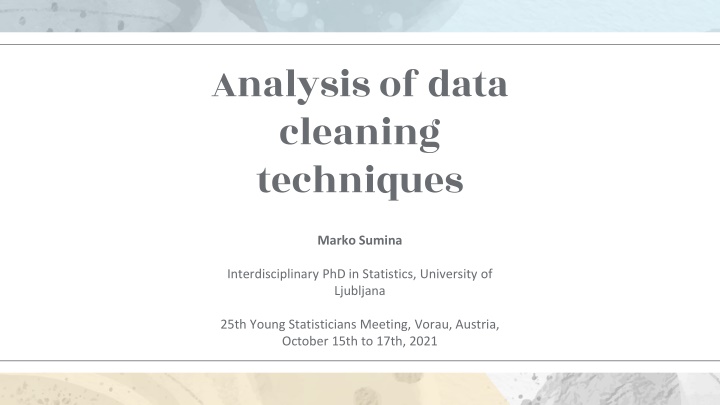Analysis of Data Cleaning Techniques for Improved Data Quality
Data cleaning is a crucial aspect of data analysis, involving the detection and elimination of errors and inconsistencies to enhance data quality. This interdisciplinary PhD research delves into various methods such as outlier detection, data deduplication, and rule-based cleaning to achieve higher levels of data quality. Statistical tests like the Grubbs test are applied to identify outliers, while normality tests assess the distribution of variables like Age, Post number, and Product code. The study focuses on a dataset from a Slovenian insurance company, aiming to optimize data quality through effective cleansing processes.
Download Presentation

Please find below an Image/Link to download the presentation.
The content on the website is provided AS IS for your information and personal use only. It may not be sold, licensed, or shared on other websites without obtaining consent from the author.If you encounter any issues during the download, it is possible that the publisher has removed the file from their server.
You are allowed to download the files provided on this website for personal or commercial use, subject to the condition that they are used lawfully. All files are the property of their respective owners.
The content on the website is provided AS IS for your information and personal use only. It may not be sold, licensed, or shared on other websites without obtaining consent from the author.
E N D
Presentation Transcript
Analysis of data cleaning techniques Marko Sumina Interdisciplinary PhD in Statistics, University of Ljubljana 25th Young Statisticians Meeting, Vorau, Austria, October 15th to 17th, 2021
Purpose of data cleaning 60% of data scientists responded that the most time consuming part of their work is cleaning and organizing data (CrowdFlower, 2016) Data cleansing involves the detection and elimination of errors and inconsistencies in data in order to improve data quality (Rahm & Do, 2000) The data cleansing approach should meet several requirements: Detect and eliminate any major errors and inconsistencies Be supported by tools that limit manual control and programming effort It must be scalable Methods include outlier detection, data deduplication, rule-based data cleaning, and human / manual data cleaning The aim of the analysis was to achieve higher levels of data quality through various techniques and approaches of data cleaning
Data type Data from the database of a typical Slovenian insurance company 178.744 unique policyholders (i.e. records) and contains 27 different coverages per cut-off date Additional data of policyholders, such as unique identification, demographic and location data was additionally collected and collated
Statistical methods 1st part The most commonly used tests for testing hypotheses are the Grubbs test (Grubbs F., 1969) and Tietjen-Moore test (Tietjen & Moore, 1972) Grubbs test = Extreme studentized deviate test: H0 : There are no outliers in the data set H1 : There is exactly one outlier in the data set 2 ?( ? 2?,? 2) 2 ?(? 2)?2 (? 1)2 ??2 ? =max(?? ?) (? 1) ? ? > ? = ? ? 2+ ?( ? 2?,? 2) Critical values T.INV (Excel) -> Analysed only numeric variables: Age, Post_number and Product_code When testing the age of the insured, the null hypothesis is rejected at ? = 0.05; maximum test statistic 5.2057 When testing the postal code, the null hypothesis is rejected at ? = 0.05; maximum test statistic 23.8433 When testing the product code, the null hypothesis at ? ? = 0.05 cannot be rejected; maximum test statistic 1.6489
Normality test Are my variables: Age, Post_number and Product_code normally distributed? The variables analyzed are clearly not normally distributed
Statistical methods 2nd part Tietjen-Moore test: generalization of the Grubbs test. Initially, you have to define the number of outliers Generalized ESD test: detection of one or more outliers in a univariate dataset. As input, it only requires an upper limit on the estimated number of outliers H0 : There are no outliers in the data set H1 : There are up to r outliers in the data set ???? ?? ? ? ? ??,? ? 1 ? ? = 1 ??= ? = 1,2, ,? ??= 2 ? ? + 1 ? ? ? 1 + ?2?,? ? 1 ? ? + 1 When testing the age of the insured the test returned two outliers When testing the Post_number the method incorrectly identifies all 5 digit city zip codes that belong to locations abroad. The test correctly returns errors in case of incorrect entry of the postal code in the form of text, but does not reject in case of entering the number 0 instead of the postal code.
Statistical methods 3rd part Kernel density estimation: Objective is to visualize the data format in a similar way as you would see in the case of a discrete histogram Process: Define a core function and place it on each data point Sum up each function 1 ? ?=1 1 ?(? ?? ? ? = ? ? = ? ? ? ?=1 ?(? ??) )
Distance based methods 1st part Mahalanobis distance: multivariate outlier analysis = multivariate Euclidean distance d variables (columns) -> d-dimensional vector ? = (?1,?2, ,??)?and covariance matrix ?,?between rv ??in ??. ? ??? 1? ? (difference from point x to vector of means ?) ?? ???????? ? = SPSS -> Mahalanobisdistance for each combination of three variables -> Excel critical values for different degrees of freedom. Each value of the Mahalanobis distance is compared to a critical value determined by degrees of freedom (determined by the number of variables) The method returns 19 outiers: Outliers in the case of wrongly inserted age The lower ages (0,1) are incorrectly identified 5 digit postal numbers
Distance based methods 2nd part Local Outlier Factor (LOF): Identifies the outlier by considering the density of the neighborhood.A data point is a local outlier if it is an outlier on the local neighborhood ????0 ????? 0 ??(?) ??(?) 0 ??(?)???? ??????(?,?) ??(?) ????? = 1/ ????? = Local outlier factor method (LOF) Age Product_code
Model based methods Model based = learned classifier applied to data to see if a point is an outlier Support vector machines (SVM) Support vector machines (SVM): divides a set of objects into classes so that the space without objects between classes or the separation boundary is as wide as possible Age Goal: Find hyperplane that separates the classes the most. The hyperplane cannot be bent Product_code
Deduplication In different databases, the same entities are written differently; there are double entries; the customer used a different name at the time of purchase etc. The goal is to find the true entity that most uniformly represents duplicate records (Ananthakrishna & Ganti, 2002). Use the method of fuzzy deduplication (also tried record lincage) Identifies mostly similar records Similarity determined by cosine similarity -> text to vector -> Compare the angle between the vectors The method also takes into account: n-gram (also separates the sequence of the sentence) + sensitivity / accuracy + TF-IDF Intermediate steps : Do these records refer to the same thing? (y)es / (n)o / (u)nsure / (f)inished . The method found no duplicate records
Rule based cleaning All other methods have difficulty finding logical errors Rule-based repairing methods are widely adopted e.g., ETL rules Formerly functional dependency and inclusion dependency -> today conditional functional dependency and conditional inclusion dependency Example: Consumer([CC= 01,AC= 908,PHN] [street,city= MH , phone number]), Our example: Tax_number([left(TN,3)=KNL] [Product_code=800,801]) Tax_number([TN= ] [Product_code =361,660,800,801]) We found incorrectly entered country names, blank entries, and incorrectly entered policyholder ages
Conclusion For data containing more than one data type we have to use completely different methods for database analysis Use statistical methods when your numerical variables are normally distributed + visual representation Use a combination of statistical and model based to extract knowledge from data i.e. data mining Use deduplication when examining on whole dataset that contains text and numeric data Use rule based to find missing logical errors We have used Python, SPSS, Excel and Wessa.net to analyse the data in different ways and from different angles With the mentioned methods, we discovered a multitude of errors in the data, which, if left undiscovered, would completely distort the results of further research!
Attachments and computer code The methods programmed in the Python 3 environment are presented via Jupyter Noterbooks and published publicly on the following GitHub account: https://github.com/MarkoSum Computer code: Fuzzy deduplication.ipynb Outlier detection LOF.ipynb SVM outlier detection.ipynb Generalized ESD test.ipynb Other documents are on my Google Drive -> email: marko.sumina@gmail.com
THANK YOU THANK YOU! ! Do you have any questions?























